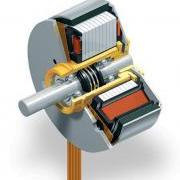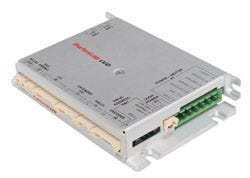Brushless Dc Motors Breathe Life into Portable Respiratory Equipment
Portable oxygen concentrators and ventilators benefit from motors with patient-friendly features and application-specific functionality
October 20, 2010
|
Maxon's EC flat motors feature high torque and a small profile for portable oxygen concentrators. |
The smaller respiratory equipment shrinks, the bigger the advantage for patients. Portable respiratory equipment such as oxygen concentrators and ventilators can free patients from the confines of hospitals and even from their homes, thanks to compact designs and battery-powered operation. These portable systems allow patients to be mobile--whether that means going shopping for the day or traveling on a plane--and can ultimately improve patients' outlook and, consequently, their quality of life.
Integral to achieving this small system size over the years has been the downsizing of motor designs. And yet, a small form factor isn't the only critical design requirement for optimizing motors for portable respiratory equipment. Motor selection also hinges on application-specific functionality, such as meeting the necessary speed requirements, as well as characteristics that factor into patient acceptance of the finished system, including noise. Additional benefits can result from working with motor suppliers capable of customization. Together, these product features and supplier custom solutions can enable respiratory OEMs and patients alike to breathe a little easier.
The Brush-Off
Offering lower noise, longer life, and greater efficiency than their conventional brushed counterparts, brushless dc (BLDC) motors tend to be the driving forces behind many respiratory applications. "With brushless motors, you have to run them with electronics--that's the down side," observes Paul McGrath, regional sales manager for Maxon Precision Motors (Fall River, MA). "The advantage is that you can run them at much higher speeds than brushed motors. You've eliminated the brushes and the commutation system as a failure mode, so you're really only limited in life by the bearings." Brushless motors generally boast a lifetime of tens of thousands of hours, compared with a lifetime of only thousands of hours demonstrated by brushed motors, McGrath adds.
In addition to significantly longer life, BLDC motors emit lower noise than brushed versions. And quieter motors contribute to a quieter finished product; audibly quiet motors are highly desirable in respiratory equipment because of the systems' proximity to patients. Noisy medical equipment can scare, stress, or annoy patients, preventing them from getting the rest they need--and that's likely the last thing OEMs want to do with their products.
Flat as a Pancake
But not all brushless dc motors are created equal; different kinds of respiratory equipment demand different features and capabilities. During the past decade, for example, portable oxygen concentrators have emerged as a breath of fresh air for patients. The portable nature of these oxygen concentrators requires motors marked by a small profile and high torque. "They're small units, and as they get smaller and get more portable, they now need a smaller motor," McGrath states. High torque enables the use of smaller motors for these space-restricted applications.
Equipped with these desired characteristics, Maxon's EC flat motors feature a large diameter coupled with a thin profile. The flat motor resembles a pancake--hence, the nickname pancake motors--and is configured with an external, multipole rotor.
"There's a shaft coming out one side of the motor. The shaft and the outer part of that pancake are rotating and the flange is the only thing that is stationary," McGrath explains. "The motors also offer a higher number of pole pairs in the motor. The higher the number of pole pairs, the more torque you can get out of the motor."
On All Cylinders
Ventilators have experienced an evolution in portability over the years similar to that of portable oxygen concentrators. Loic Lachenal, medical segment manager at Portescap (West Chester, PA), recalls the old-fashioned ventilators that once could be seen in hospitals. Enormous by today's standards, the equipment was built with giant air pistons that moved up and down to help deliver therapies to patients.
Now, he notes, ventilators are often barely bigger than a shoe box and deliver therapies via a fan component called a blower. Critical to system performance, current ventilator motors must also be able to rapidly accelerate and decelerate to ensure effective delivery of air and oxygen. To do so, the system needs to correspond to the patient's breathing patterns. Upon receiving a signal, the motor has to rapidly accelerate to ensure that therapy delivery coincides with patient inhalation. Likewise, the motor quickly decelerates during exhalation or when therapy is not needed.
To accommodate these high speed and small size requirements, motor suppliers often suggest small-diameter, cylindrical motors for high-end ventilator applications. Featuring a 22-mm diameter, the low-inertia, slotless 22BH-series brushless motors manufactured by Portescap fit the bill. "The range of Portescap 22BH-series motors allows medical treatments to be delivered in the common bilevel, pressure-controlled mode, as well as the volume-controlled mode, which usually is the most demanding and involves invasive therapy through the trachea in the ICU as opposed to using a face mask," Lachenal says. "This is to say that the range of our 22BH product covers all ends of the ventilation business--from the slightest breathing disorder to life support."
|
Portescap 22BH-series motors can meet the high speed and rapid response requirements of portable ventilators. |
Although current 22BH motor models meet speed and torque requirements for ventilators, next-generation versions will be optimized to achieve higher speeds in respiratory applications, according to Lachenal. Higher speeds, he notes, can increase the pressure at which therapies are delivered. Consequently, a broader range of conditions could be treated. Speeds could increase from about 30,000 rpm up to roughly 50,000 or 60,000 rpm. "Portescap high-speed motors are being qualified in next-generation ventilation devices capable of delivering more than 100 cmH²0 of pressure and 200 L/min flow," Lachenal states. "This is significantly higher pressure and flow than current devices."
Higher speeds generate more heat, however. With this in mind, Portescap has worked to optimize coils and lamination materials in order to maintain or to lower temperatures despite the increasing speeds achievable by the new motors. Keeping temperatures down can ultimately help to prevent overheating and ensure reliability of the end product.
Able to Adapt
While many motor suppliers specialize in standard designs, Ametek Technical & Industrial Products (Kent, OH) prides itself on offering customized solutions to suit a given respiratory application, according to Phil Faluotico, director of motor engineering. "A high percentage of our products are 'highly engineered' solutions to meet a custom application," he says.
Such an engineered solution may derive from simply modifying a product from the company's standard line to meet an OEM's needs. For these cases, Ametek may optimize the 1.7-series Pittman BLDC servomotors, which are available in 1.7 × 1.5-, 1.7 × 1.9-, and 1.7 × 2.6-in. versions for a variety of portable respiratory equipment applications. They feature a continuous torque of 3, 5.75, and 11 oz-in. and a speed at continuous torque of 10,750, 2425, and 3000 rpm, respectively.
In terms of customization, however, the company can work with OEMs to tailor the motor, blower, or drive specifications. "We offer motors only, motors with Hall sensors, and motors with integrated drives," Faluotico states. "The drives are customized and depend on the level of sophistication of control of the motor." The company counts its ability to integrate the motor with the air-moving force in the drive among its specialties.
"I think a lot of companies will look to offer one standard motor and produce just that model," Faluotico says, "while Ametek is willing to go in either from a ground-up design or a modified standard to be able to work with a customer from a startup phase to pilot production into full production."
You May Also Like




